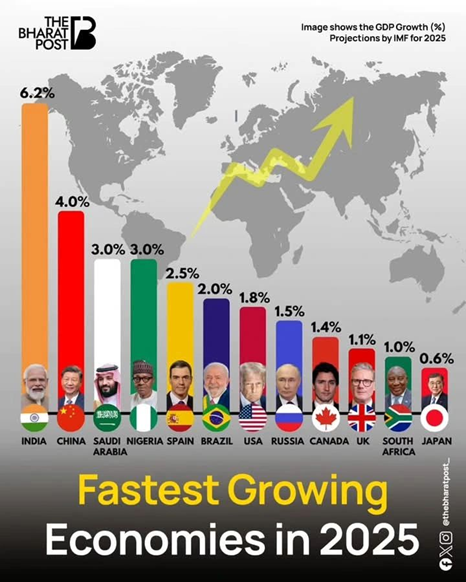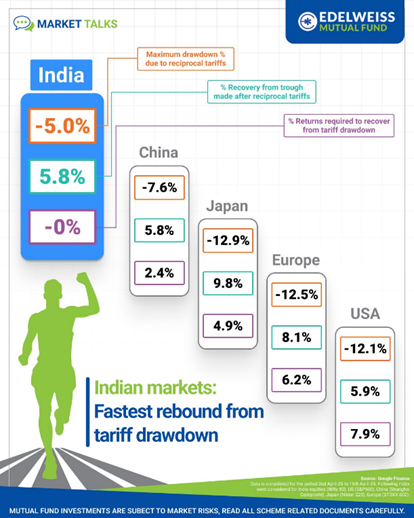CAGR Insights is a weekly newsletter full of insights from around the world of the web.

Chart Ki Baat

Gyaan Ki Baat
RBI’s Latest Rate Cut – What It Means for Your Money
On June 6, 2025, the Reserve Bank of India (RBI) surprised the markets by slashing the repo rate by 50 basis points, bringing it down to 5.5%. This marks the third rate cut of the year and the sharpest since the COVID-era emergency cuts in 2020.
So, what does this mean for you?
First, borrowing just got cheaper. If you have a home loan, car loan, or are planning to take one, this could be great news. Lower repo rates mean banks will reduce lending rates, which translates to lower EMIs. For example, on a ₹50 lakh home loan, your monthly instalment could drop by a few thousand rupees—real savings over the long run.
Second, the RBI also reduced the Cash Reserve Ratio (CRR) by 100 basis points to 3%, boosting liquidity in the system. Banks now have more money to lend, and we may see a surge in credit availability, especially for small businesses and retail borrowers.
However, RBI has kept its policy stance ‘neutral’, signalling that this may not be the beginning of an aggressive rate-cut cycle. Inflation remains a concern, so don’t expect a series of back-to-back cuts.
Stay informed and let your money decisions align with the changing winds of policy.
Personal Finance
- RBI repo rate cut by 50 bps: What fixed deposit investors should do now: The RBI slashed the repo rate to 5.5% and CRR by 100 bps, aiming to boost growth amid low inflation. FD investors face falling returns, urging a shift toward smarter strategies like laddering, bonds, and diversified investment options. Read here
- Can I achieve 10 Crores in 15-20 years if I can invest Rs. 75K a month? At 32, a consultant with ₹12L in equity and ₹75K/month to invest wants to hit ₹10Cr in 15–20 years. Should it all go to equity, bonds, or split 50:50? Read here
- Buying a house in your 40s or 50s: Which is the smarter financial move? A 53-year-old jobless Redditor sparked debate by living stress-free in his ₹2 crore home, bought debt-free. His advice? Delay homebuying, invest early, avoid FOMO. Financial experts echo: timing, stability, and discipline matter more than rushing into EMIs too soon. Read here
Investing
- What’s the Best Withdrawal Strategy in Retirement? Navigating retirement? This article explores smart withdrawal strategies—from the classic 4% Rule to flexible, guardrail, bucket, and income-only methods. Each has pros and cons, but the best plan depends on you. Discover how to spend wisely—and sleep soundly—in retirement. Read here
- Started investing in your 40s? Keep these 5 crucial factors in mind: Investing in your 40s requires disciplined planning, risk management, debt control, and smart asset allocation to build wealth, support future goals, and secure a stress-free retirement. Read here
Economy & Sector
- At a crossroad: India cannot claim to be a powerful economy in terms of inclusive growth in the way the US or Germany or Japan can. India still contains a large informal sector with growing economic inequalities. Read here
- The critical importance of Census 2027 for India’s economy: The national Census provides the fundamental statistical basis for all other types of surveys and analysis in the country. In other words, the Census is a reality check for the country — a look in the mirror without which a self-portrait is not possible. Read here
- India to become world’s 4th largest economy: A giant GDP leap, but for whom? Is this growth inclusive? India’s rise to the world’s fourth-largest economy reflects impressive growth, but questions of inclusivity, equity, and per capita progress remain. Read here
****
Check out CAGRwealth smallcase portfolios
Our smallcase portfolios are ranking well in the smallcase universe in terms of 1-year returns.
• CFF (launched in June 2022) – Ranked 1st amongst smallcase with medium volatility.
• CVM (launched in May 2022) – Ranked among Top 20 across the Momentum smallcase universe.
Do check it out here
****
That’s it from our side. Have a great weekend ahead!
If you have any feedback that you would like to share, simply reply to this email.
The content of this newsletter is not an offer to sell or the solicitation of an offer to buy any security in any jurisdiction. The content is distributed for informational purposes only and should not be construed as investment advice or a recommendation to sell or buy any security or other investment or undertake any investment strategy. There are no warranties, expressed or implied, as to the accuracy, completeness, or results obtained from any information outlined in this newsletter unless mentioned explicitly. The writer may have positions in and may, from time to time, make purchases or sales of the securities or other investments discussed or evaluated in this newsletter.






